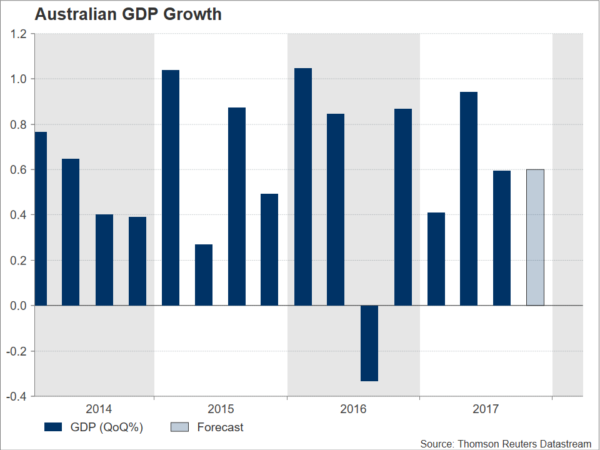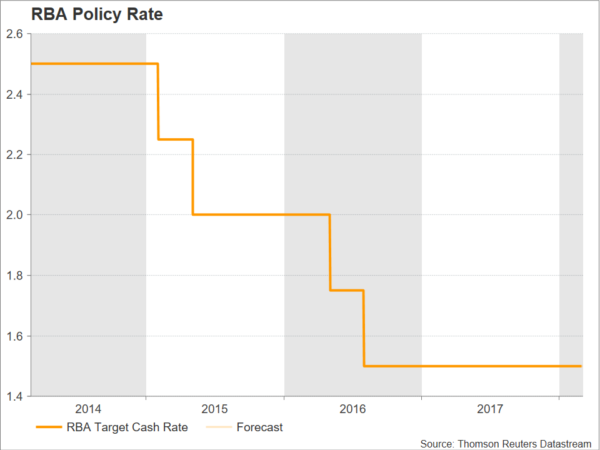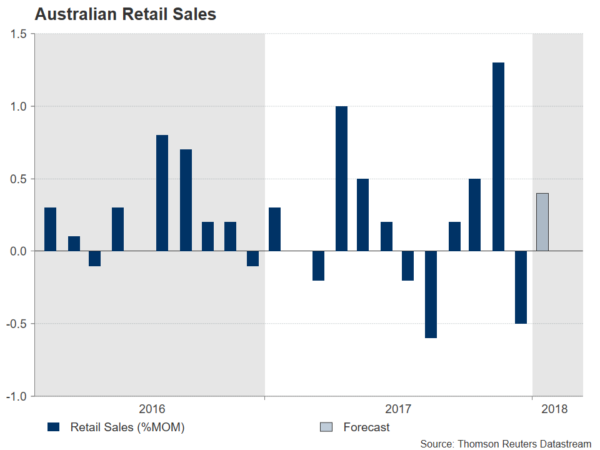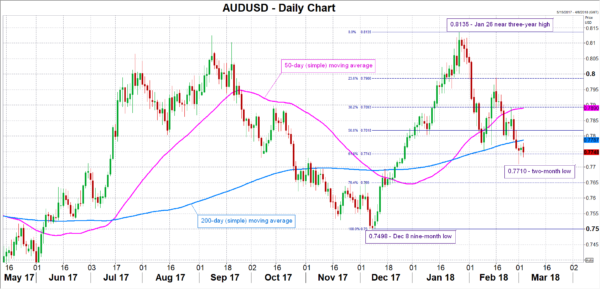The Reserve Bank of Australia will be completing its meeting on monetary policy on Tuesday, with a decision on the Bank’s policy rate being made public at 0330 GMT. Markets widely expect the central bank to keep rates unchanged, with the market’s focus falling on the RBA’s remarks on the outlook for the economy and inflation which could offer hints as regards its monetary policy plans moving forward.
RBA policymakers are expected to support maintaining the cash rate, the central bank’s policy rate, at the record low of 1.5% upon completion of the Bank’s monthly policy meeting next week.
Given that no change in rates is expected, attention would fall on the Bank’s optimism – or lack thereof – on the Australian economy moving forward. The RBA has in the past expressed concern on wage growth – that has the capacity to spur inflationary pressures, pushing annual inflation within the Bank’s target of 2-3% – which has been dismal despite an overall improving business investment and labor market. Comments on this front will be eagerly anticipated by market participants. It is noteworthy as well though that in its previous assessment, despite the not so upbeat views on workers pay, the Bank said it expects economic growth to accelerate, exceeding 3% over the next couple of years.
Any remarks on the threats posed by household debt, which has been hovering around record-high levels and constituting yet another reason for the RBA’s reluctance to deliver a rate increase in the past, will also be attracting attention; the household debt issue is also linked to real estate prices reaching “bubbly” levels, at least according to analysts, in certain cities.
Earlier in the day (at 0030 GMT), retail sales for the month of January, as well as Q4 2017 current account and net exports contribution to growth data will also be attracting interest out of Australia. Retail sales, which can be used as a gauge for household spending that makes up more than 50% of the Australian economy’s annual GDP, are expected to rise by 0.4% after contracting by 0.5% in December. It should be mentioned though that overall Q4 2017 retail sales numbers were upbeat despite the fall during the last month of 2017, pointing to an improving outlook for economic activity.
An optimistic tune by the RBA, one that kindles expectations for tightening sooner than previously anticipated, and stronger-than-anticipated data out of Australia are likely to push aussie/dollar higher. The current level of the 200-day moving average at 0.7787, in combination with the 50% Fibonacci mark of the December 8 to January 26 upleg at 0.7818, could act as a resistance zone to price advancing. Further above, the focus would shift to the range around the 38.2% Fibonacci level at 0.7893, with the area around it also encapsulating the 50-day MA at 0.7890 and the 0.79 handle that may hold psychological significance.
On the other hand, should the RBA sound concerned on the economy’s outlook, or the data out of the country disappoint, then aussie/dollar is expected to decline. The pair is under pressure, falling considerably after reaching a near three-year high of 0.8135 in late January. A continuation of the declines might meet support around the 61.8% Fibonacci level at 0.7743. Price action is taking place close to this level, with a downside violation bringing into view the 76.4% Fibonacci mark at 0.7650, while the area around last Thursday’s two-month low of 0.7710 could also provide support.
Year-to-date, the Australian currency is down by around 0.7% versus its US counterpart. In 2017, it advanced by 8.1%, spurring policymakers’ unease as an appreciating currency is seen a weighing on the country’s exports – and thus the growth outlook – as well as on inflationary pressures. This year’s underperformance might translate into the absence of a currency talk-down by RBA policymakers.
At the moment, the majority of analysts supplying their forecasts to Reuters project that the RBA will not deliver an interest rate increase before Q3 2018, but 14 out of 27 anticipate at least one quarter percentage point hike by the end of the year.
The country’s Q4 2017 GDP figures are due on Wednesday at 0030 GMT. Quarter-on-quarter and year-on-year, the pace of expansion is projected to stand at 0.6% (same pace as in Q3) and 2.5% (versus 2.8% in Q3) respectively. It is perhaps important to mention within the context of growth figures, that last week’s data on Q4 capital expenditure surprised to the downside, with private capex recording a fall by 0.2% rather than the 0.9% expansion that was forecast by analysts. The data were met with a selloff in the Australian currency.















